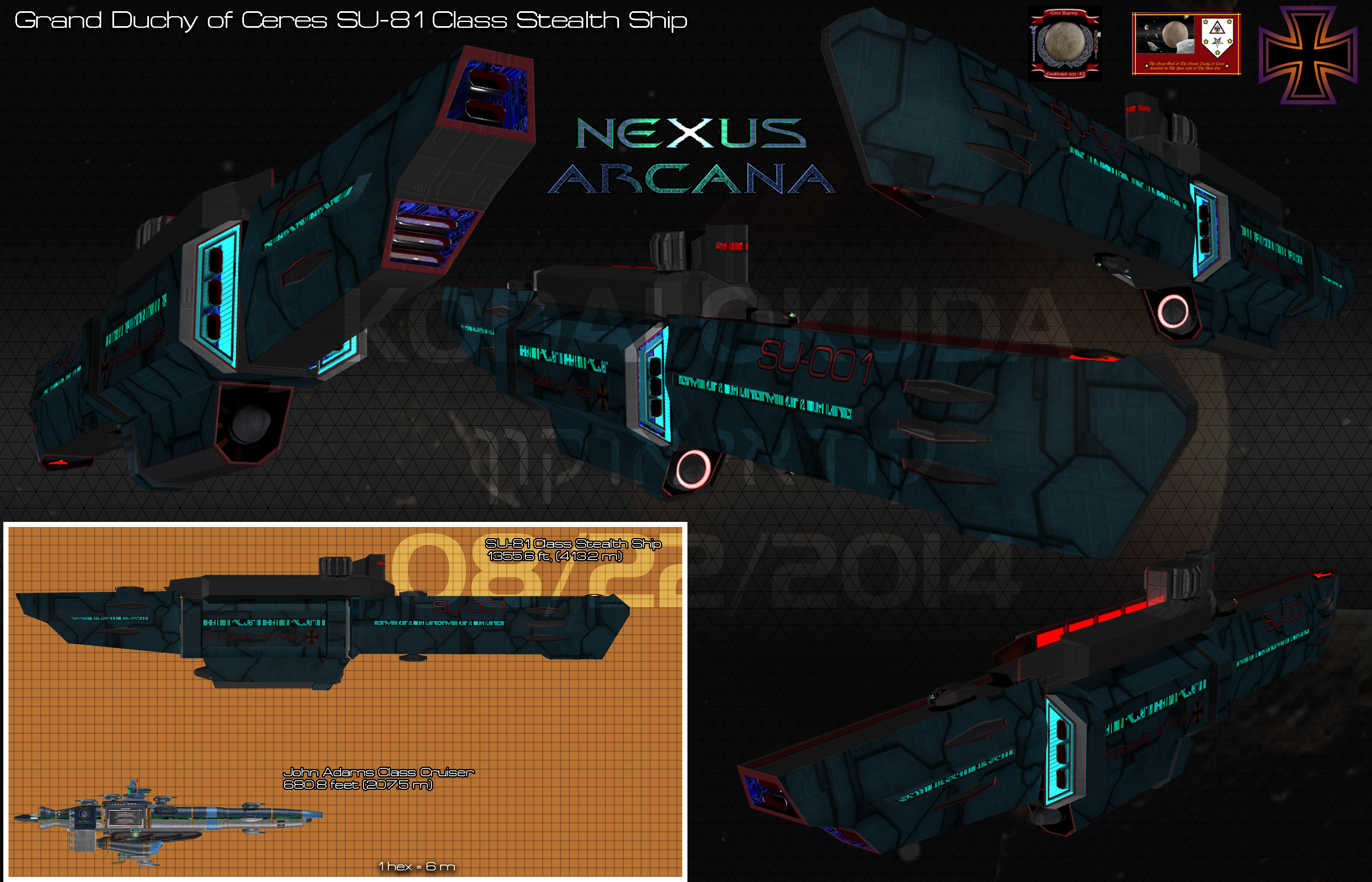 |
||
 |
||

GOVERNMENT: Grand Duchy of Ceres (originally developed by the Ceres Regency)
TYPE: Stealth Unit (a.k.a. Space Sub)
MODEL: SU-81
DATE INTRODUCED: 2181 AD
LENGTH: 1355.6 feet (413.2 meters)
WIDTH: 168.9 feet (51.5 meters)
HEIGHT: 300.9 feet (91.7 meters)
MATERIAL: Crystal Composite
POWER PLANT:14x Ceres Energy CEFR-98.5K (Level III)
OUTPUT: 98,500 megawatts wach(1,379,000 megawatts total)
ARMOR TYPE: Crystal Composite "Stealth" material
ARMOR THICKNESS: 3 inches
DISPLACEMENT: 140,000 tons
CREW: 655 + 20 pilots (675 total)
CREW ROSTER: 6 GUNNERS, 140 ENGINEER, 140 ELECTRICIAN, 140 TECHNICIAN, 140 OPERATOR, 57 OFFICERS, 32 MEDICAL, 20 pilots
PROPULSION
FASTER THAN LIGHT DRIVE:
1x Ceres Drives CD-ID-T3-50000 Intersection Drive
SPEED: 0.64* Light years per hour (time dilation)
*Designed for a 500,000-ton ship
SUBLIGHT PROPULSTION (PRIMARY):
3x Ceres Industrial CI-EMD-T3-70K Electromagnetic Drive
SPEED: KiloMACH 10 each (7,600,000 mph each; 22,800,000-mph total
SUBLIGHT PROPULSTION (AUXILLIARY):
14x Hanubeau Dynamics HD-HYIE-14K
SPEED: 7600 mph each*
(Delta-V: 60,800 mph for foward, 45,600 mph reverse, 22,800 mph port/starboard, 30,400 mph top/bottom.
)
WEAPONS:
(PRIMARY TACTICAL WEAPONS):
3x Mawzer MPC-400 400-megawatt PHELAC; Effective Range: 3200-miles; Payload: unlimited with clutch; ROF: three blasts per twenty seconds or 6-blasts per minute.
(PRIMARY BALLISTIC WEAPONS):
1x Gever G-ITL-MarkII (Ion Torp); Missile Type: IDST-5000 ion drive space torpedo with computer-guided 5000-pound warhead;Effective Range: 844.4 miles; Payload: 5 space torpedoes each in an autoloading torpedo tube; ROF: 1 torpedo per two seconds with a cyclic rate of 30 torpedoes per minute per torpedo tube.
ELECTRONICS:
1x Microwave Radio Communications array with a 1AU range.
1x SLV communications system with 10-light years range
1x Passive EMS array with a range of 1,000,000 miles.
1x Active EMS array with a range of 100,000 miles.
1x LADAR arrawy with a range of 220,000 miles.
1x SLV sensor suite array with a range of 80 parsecs (260.8 light years).
DEFENSE SYSTEMS:
LIGHT BENDING SHIELDS
1x Ceres Research LBS-700K; Effective Range: hull; NUMBER: 1F; POWER REQ: 700,000-megawatts; Effect: Most sensors have a 30% chance of detecting the ship. Lasers and PHELACs do no damage to shield, provides complete protection. Makes the ship totally invisible in the visible light spectrum.
DEFLECTOR SHIELD GENERATORS
6x Europa Research ER-DF-2000A LVL-2 Gravitonic deflector field generators; Effect: has an output of 432 Terajoules and a regeneration rate of 43.2 Terajoules every ten seconds.
Description/Overview:
The SU-81 series was the product of the Advanced Research and Development group at the UNSC base on Io prior to the start of the 1st Interplanetary War. This team was working on the first faster-than-light drive system that would eventually become the T-1 Intersection Drive system in 2166 AD. Initially this system was deemed a failure because all it did was generate a warp bubble that bent space-time around it, but no where near enough to “jump” through warpspace. Thus the UNSC AR&D team discarded the design as being a failure since the goal of their team was to develop a usable FTL system. Dalltan however, understood the possible application that such a generator could be used for after the plans came across his desk in 2167 AD. Immediately the then Premier of the Solar Empire had his most trusted science teams begin refining the generator into a workable cloaking device. It was not until the late 2170s that his team—who had been transplanted to Ceres in 2178—finally perfected a light bending shield generator for use on a spacecraft.
Unfortunately for the Ceres Regency, none of their spacecraft of the late 2170s was capable of using the LBS effectively due to the fact that even with the light bending shield generator, RADAR, and EMS sensor arrays could still detect the standard warships of the Ceres Space Navy. Therefore, an entirely new vessel—equiped with stealth armor—was designed to use the light bending shield array. By 2181 this new craft, dubbed the SU-81, was put into production. This new vessel used both the light bending shield generator and RADAR/EMS absorbant armor to give it near total invisibility both in the visible spectrum of light and the electromagnetic and radio frequency ranges.
The SU-81 Steath Unit was fitted with one Ceres Drives CD-ID-T3-50000 Type-3 Intersection Drive unit for faster-than-light travel. Three Ceres Industrial CI-EMD-T3-70K Electromagnetic drive acted as the primary sublight engine for cruising at interplanetary speeds within a solar system or planetary sphere. The most unique system of the SU-81 was its fourteen “auxilliary” Hanubeau Dynamics HD-HYIE-14K Ion engines. These drives were mounted on the craft in clusters to give the vessel the ability to dodge quickly in space.
Ten Gever G-ITL-MarkII Ion torpedo launch tubes were mounted on the ship–six forward and four aft–and acted as the SU-81 Steath Unit’s primary weaponry. Even though three Mawzer MPC-400 PHELAC turrets were also fitted to the spacesub, these turrets were not normally usable due to the light bending shield generator of the vessel. The three PHELACs were intended for emergency use only.
A Ceres Research LBS-700K light bending shield generator was the primary defense system of the SU-81 type steath ship. This generator made the craft totally invisible, and also impervious to both laser and PHELAC weaponry. Although it made the craft totally invisible to visual systems and LADAR (or other light based sensors/systems), electromagnetic sensors and RADAR could detect the craft. This is why the SU-81 also used steath armor that absorbed both EMS and RADAR particles, making the craft virtually undetectable and a truly “steath” craft in space.
The secondary defense systems were six Europa Research ER-DF-2000A LVL-2 Gravitonic deflector field generators were added.
The SU-81 was only a partial success during the intial phase of the Ceres conflict. This craft caused such alarm among the Jovian governments that they developed the first NADAR (Neutrino Acquisition Detection And Ranging) sensor systems to contend with this class of warship. Only 200 SU-81s were built by the Grand Duchy and all were lost during the Ceres conflict.